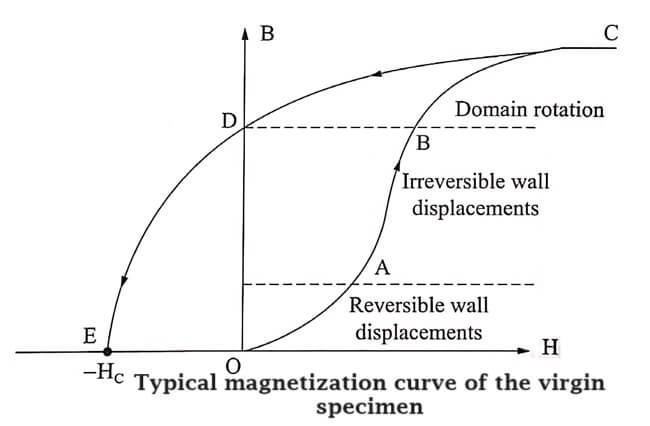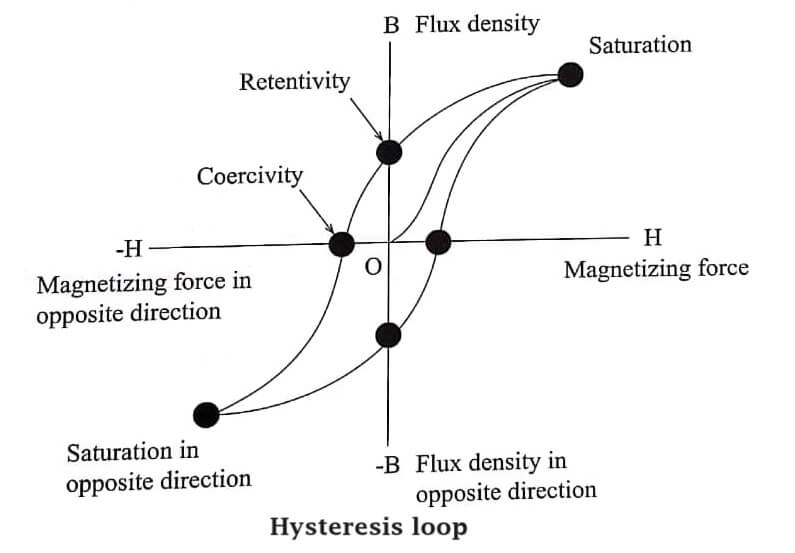Hysteresis Loop: The word hysteresis literally means lagging behind. “Hysteresis is the phenomenon of lagging of magnetic induction (B) behind the magnetising field (H) of a ferromagnetic material when the specimen is at critical temperature.
It is also defined as when a ferromagnetic material is taken through a cycle of magnetisation, the variation of B (magnetic induction) with respect to H (applied field) can be represented by a closed loop (or) curve (hysteresis loop or curve)” is called hysteresis.
A graph is drawn plotting magnetic field strength ‘H‘ along Z-axis and magnetic induction ‘B‘ along Y-axis as shown in Fig.
The magnetic induction (B) increases along the curve OA with the magnetic field (H). Beyond the point A, even if the magnetic field is increased, the magnetic induction does not increase and it remains constant. At this point, the specimen is saturated with magnetization.
The value of magnetic field is decreased, but the magnetic induction does not decrease at the rate at which it is increased. When H=0, B≠0, the magnetic induction has a definite value represented by OB and it is known as Retentivity.
The applied magnetic field H is reversed and increased gradually till the point C is reached. The magnetic induction B becomes zero at the point C and negative magnetic field strength applied to remove residual magnetism is denoted by OC and it is known as Coercivity.
Further increase of magnetic field H, the magnetic induction increases along CD in the reverse direction as shown in the graph. If the magnetic field is varied backwards, the magnetic induction follows a curve DEFA.
This will complete one cycle of magnetization. The loop ABCDEFA is called hysteresis loop.
From the above fact, it is clear that the magnetic induction B will not become zero, when the magnetic field strength H is zero. It shows that the magnetic induction lags behind the applied magnetic field strength.
This lagging of magnetic induction behind the applied field strength is called magnetic hysteresis.
Retentivity or Residual magnetism
Retentivity or residual magnetism is the amount of magnetic induction retained in the material after removing the magnetising field. It is represented by OB in the B-H curve (Fig).
Coercivity or Coercive force
Coercivity or coercive force is the amount of magnetizing field applied in the reverse direction to remove the residual magnetism completely from the material. It is represented by OC in the B – H curve fig.
Hysteresis loss
When the specimen is taken through a cycle of magnetization, there is a loss of energy in the form of heat. This loss of energy is known as hysteresis loss.
The area of the loop represents energy loss per cycle per unit volume of the specimen.
Explanation of Hysteresis on the basis of Domain theory
It is found that when a ferromagnetic material is subjected to an external field, there is an increase in the value of the resultant magnetic moment of the specimen.
This is due to
- Motion of domain walls
- Rotation of domain walls
When a small external field is applied, the domain walls are displaced slightly in the easy direction of magnetisation. This gives rise to small magnetization corresponding to the initial portion of the hysteresis curve (OA) as sown in Fig.
When the applied field is removed then the domains return to its original state and is known as reversible domains.
It is field is increased, large number of domains contribute to the magnetization and thus the magnetization increases rapidly with H.
Now, even when the field is removed, because of the displacement of domain wall to a very large distance the domain boundaries do not come back to their original position. This process is indicated as AB in the Fig and these domains are called irreversible domains.
At point ‘B‘ all the domains got magnetized along the easy direction.
Now, when the field is further increased, the domains start rotating along the field direction and the anisotropic energy is stored in the hard direction represented by BC in Fig.

Thus, the specimen is said to have attained the maximum magnetisation. At this position, even after the removal of external field the material posses maximum magnetization called residual magnetism (or) retentivity represented by OD in Fig.
On the removal of the external field, the specimen will try to attain the original configuration by the movement of Bloch wall. But this movement is stopped due to the presence of impurities, lattice imperfections etc. Therefore to overcome this, a large amount of reverse magnetic field is applied to the specimen. The amount of energy spent to reduce the magnetisation to zero is called coercivity represented by OE in the Fig.
Importance of Hysteresis Curve
The hysteresis curve of a ferromagnetic material provides us very useful information about the properties of a material. It helps us to select a particular material for in particular technical purpose.
They are as follows:
- The shape and size of the hysteresis curve of a ferromagnetic material is a characteristic of the magnetic material.
- It provides information regarding retentivity, coercivity, permeability, susceptibility and energy loss per cycle of magnetisation.
- It helps to select a material that should be used for making permanent magnet, electromagnet or core of transformers and dynamos.
What does hysteresis loop represent?
A hysteresis loop represents the relationship between two variables, typically depicting the lag or delay in the response of one variable to changes in the other. One common example is the magnetization of a material in response to changes in an applied magnetic field. In the context of magnetism, a hysteresis loop shows how the magnetization of a material changes as an external magnetic field is applied and then removed. The loop illustrates the “history” or path the material takes in terms of its magnetic state. The loop is closed, indicating that the material retains some level of magnetization even when the external magnetic field is removed. Hysteresis loops are also found in other physical systems and processes, such as in electrical circuits, mechanics, and control systems. The loop provides insights into the dynamic behavior and memory effects of the system, showcasing how the response of one variable depends on its past states and the inputs it has experienced.
| Read More Topics |
| Classification of magnetic materials |
| Domain theory of ferromagnetism |
| Definition and properties for ferromagnetism |






